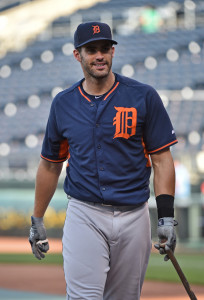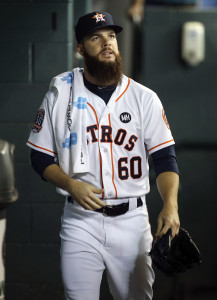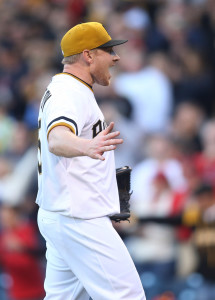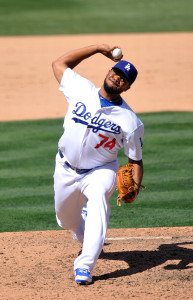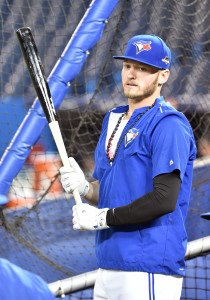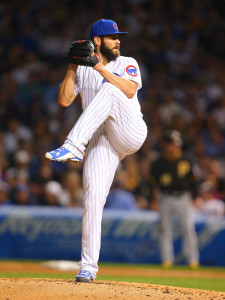Over the next few days, I will be discussing some of the higher profile upcoming arbitration cases. I will rely partly on my arbitration model developed exclusively for MLB Trade Rumors, but will also break out some interesting comparables and determine where the model might be wrong.
As I discussed in my write-up on Jacob deGrom and Carlos Martinez, it has been difficult for starting pitchers to top Dontrelle Willis’ arbitration salary of $4.35MM in his first year of arbitration eligibility back in 2006. Dallas Keuchel finally broke that record last year, but otherwise many pitchers have fallen short. In many cases, pitchers have gotten close only to sign multi-year deals to remove themselves from the list of comparables, and other times they have settled for numbers at or just short of Willis’ old record.
My model has trouble with these symbolic barriers, and I have written many articles about why pitchers projected to earn slightly more than $4.35MM would earn slightly less. Mathematical modeling is a science, but it does not pick up on the psychological nuances of a precedent being broken. It remains to be seen whether Keuchel’s new record makes it easier for pitchers to out-earn Willis—and Carlos Martinez this year could be a great case. However, despite Gerrit Cole of the Pirates, Jake Odorizzi of the Rays, and Collin McHugh and Mike Fiers of the Astros all projecting near the $4.35 mark—Odorizzi and McHugh are projected slightly above it—I suspect all four will earn slightly less than their projections because of this barrier.
All four of Cole, Odorizzi, McHugh, and Fiers have at least 30 career wins, 500 career innings, 400 career strikeouts, and 100 platform year innings. All of them also have relatively average ERAs in the 3’s or 4’s. None won the Cy Young Award last year. There are only four such pitchers who met these criteria to receive one-year arbitration deals as first-year starting pitchers in the last three years, and all four earned in a tight range of $3.63MM to $4.35MM. These include Shelby Miller, Chris Tillman, Mike Minor, and Jake Arrieta. It is difficult to see any of these four pitchers falling out of that range.
Gerrit Cole is projected to earn $4.2MM, but his case is somewhat unique in that he had a relatively weak platform year despite a strong career. He went 7-10 last year, but his 47-30 in his career. His 3.88 last year is worse than his 3.23 career mark. He only threw 116 innings with 98 strikeouts last year, but he has thrown 579.1 innings with 538 strikeouts in his career. Good comparables will include players with high career wins but low platform year wins. Ivan Nova is a reasonable comparable, although he earned just $3.3MM three years ago. He had a 9-6 record with a 3.10 ERA in 139.1 innings, but was 38-20 in his career with 4.04 ERA in 517 innings. Cole’s career numbers are definitely much better than Nova’s, but Nova makes sense as a floor. I suspect Cole will get a raise over Nova’s salary plus some extra money for inflation and will end up in the $3.5MM to $4MM range, probably right in the middle—well short of his arbitration projection of $4.2MM.
Jake Odorizzi went 10-6 last season with a 3.69 ERA in 187.2 innings along with 166 strikeouts. He only has 30 career wins, fewer than the other three guys on this list, but he does have 562 career innings and a 3.75 career ERA, along with 516 strikeouts. His best comparable is probably Doug Fister four years ago, who also won ten games and had a similar ERA at 3.45. Fister also had 30 career wins and a 3.48 ERA in 610 career innings. Fister struck out over a hundred fewer batters in his career at the time he earned $4MM exactly, so adding in some salary inflation should be Odorizzi comfortably in the low 4’s. However, it is hard to find a reason why Odorizzi would top Matt Harvey, David Price, Shelby Miller, or Chris Tillman, all of whom earned between $4.32 and $4.35MM. My model projects Odorizzi at $4.6MM but my gut says $4.2MM.
Collin McHugh had a 4.34 ERA last year and has a 4.13 career ERA, so his run prevention resume is unimpressive compared to the other pitchers in this group and many other potential comparables. However, McHugh won 13 games last year and has won 43 in his career, which is a rare feat. There are only two pitchers in the last six years who have won at least 12 games in their platform years and 40 in their careers while having ERAs above 4.00. These include Ian Kennedy, who earned $4.26MM in 2013, and Tommy Hanson, who earned $3.72MM in the same year. Kennedy’s numbers are largely similar to McHugh’s, but slightly better in many aspects. Hanson was slightly behind McHugh in most categories. Given how stale these comps are, I think McHugh should pass the midpoint of around $4MM, but I also see him struggling to make a case for besting $4.35MM. I think something like $4.1MM or $4.2MM is likely, which is also below his $4.6MM projection.
Michael Fiers 4.48 platform year ERA will definitely dent his case, although his 3.87 career ERA is more impressive. He also has 11 platform year wins and 34 career wins, along with a platform year of 168.2 innings with 134 strikeouts. Jeremy Hellickson’s 2014 case is a great match. He had only one fewer loss, although Hellickson’s 5.17 ERA is definitely much worse than Fiers’ 4.48. His 39 career wins to that point best Fiers, but his 409 career strikeouts fall far below Fiers’ 542. Hellickson earned $3.63MM back in 2014, so with a more impressive platform year ERA plus three years of salary inflation, we would expect Fiers to easily top Hellickson’s salary. It is difficult to find much evidence that Fiers will hit his $4.3MM projection, though, since many of the pitchers in that range have much better cases than he does. I suspect he may be able to get close to $4MM, but probably not top it.
All four of these pitchers are likely to earn a few hundred thousand dollars less than they are projected to earn. My arbitration model tends to miss these sorts of subtleties, and a longstanding symbolic barrier at $4.35MM definitely has skewed salaries in this range down a few hundred thousand dollars. Keuchel’s new record is much higher than Willis’ old record, but several other pitchers will probably need to top $4.35MM before the model results are smooth enough that we can stop shaving money off these projections.

